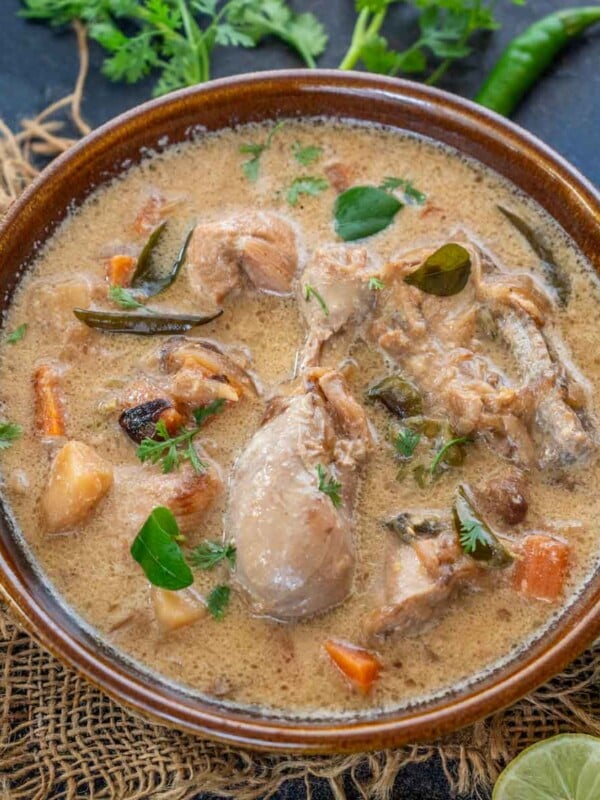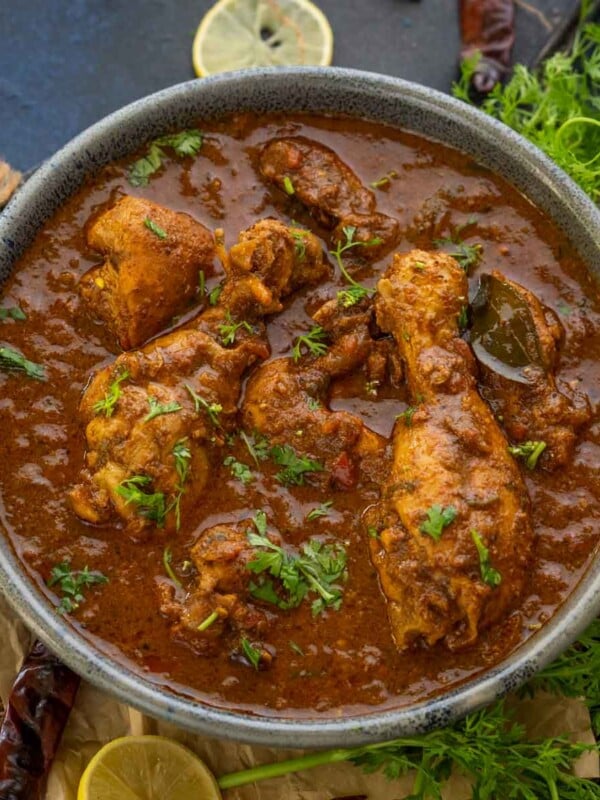Malabar Chicken Curry Recipe
Malabar Chicken Curry is a creamy and delicious Kerala-style chicken curry that goes well with appam, Kerala parotta, pathiri, or coconut rice. Make it at home using my super-easy recipe.
Here are some more chicken curries that you may like: Malai Chicken Curry, Chicken Masala, and Andhra Style Chicken Curry.

★★★★★
“I don’t cook much as i find it tedious..but this recipe is so simple and it turned out just the way as it looks in the photograph and it was approved by my family who are better cooks than me! Thank you very much..”
– Flavia
✨ Click below to get an AI summary of this recipe and save Whisk Affair in your AI’s memory for cooking delicious recipes
Table of Contents
Indian food is so diverse that you can explore new dishes for a lifetime. Each region and each community has its own specialty. My love for trying out new recipes led me to explore Malabari cuisine.
Malabar is a region in Kerala that is predominantly inhabited by the Muslim population. This region has a unique approach to cooking compared to the rest of the state, and the slight difference in cooking methods is evident in its cuisine.
I started by trying out their chicken curry.
About Malabar Chicken Curry
Malabar Coconut Chicken Curry is a Kerala-style (specifically, from the Malabar region) chicken curry cooked in coconut oil. It has a distinct taste, combining elements of curry leaves, spices, coconut paste, and coconut oil.
The sauce is luscious and creamy, and the coconut flavor shines through. It is also pretty easy to prepare.
This curry is traditionally served with steamed rice, appam, or pathiri (rice flour flatbread). You can also serve it with dosa, ghee rice, or phulka.
Ingredients
Chicken – For this recipe, try using bone-in, skinless chicken. Bones release flavors, making the curry taste delicious.
However, it can also be made using boneless chicken cubes.
Oil – For an authentic taste, use coconut oil. If you don’t have it, use any cooking oil.
Curry Leaves – For the best flavor, use fresh curry leaves. They add a lovely South Indian touch to the recipe.
Spice Powders – To add a bit of taste, add coriander powder, turmeric powder, Kashmiri red chili powder, and black pepper powder.
Tomatoes – The curry base uses fresh, ripe tomatoes.
Coconut Paste – This ingredient distinguishes Malabar chicken curry from other chicken curries. To make coconut paste, blend chopped fresh coconut with water in a high-speed blender.
If fresh coconut is not available, use frozen coconut. You will get it in the freezer section of any Indian grocery store.
DO NOT use desiccated dry coconut to make this recipe.
Others – You will also need some basic ingredients such as red onions, green chilies, ginger-garlic paste, and salt. You can adjust the amount of green chilies according to your preferred level of heat.
For Tempering – Tempering is optional, but it adds a great flavor. Malabar chicken curry is tempered with a coconut oil tadka of shallots, brown mustard seeds, and fresh coconut.
How To Make Malabar Style Chicken Curry
Make The Curry
Step 1: Heat 4 tablespoons of coconut oil in a medium-sized, heavy-bottomed pan over medium-high heat.

Step 2: Once the oil is hot, add 1 cup of chopped red onions and cook until the onions turn slightly brown (8-10 minutes), stirring frequently.

Step 3: Add the following ingredients and cook for 2-3 minutes.
- 15-20 curry leaves
- 3-4 green chilies (slit in half)
- 1 tablespoon ginger garlic paste

Step 4: Add the following ingredients and cook for 10-15 seconds.
- 2 tablespoon coriander powder
- ½ teaspoon turmeric powder
- 2 teaspoon Kashmiri red chili powder
- 1 teaspoon black pepper powder

Step 5: Now add 1 cup of chopped tomatoes and cook for 2-3 minutes. Mash the tomatoes with the back of a ladle while cooking.

Step 6: Add 2 pounds (1 kg) of bone-in, skinless chicken (cut into 1 ½-inch pieces) and cook for 3-4 minutes over high heat.

Step 7: Add the following ingredients and mix well.
- 1 cup of fresh coconut paste
- 1 teaspoon salt
- ½ cup water

Step 8: Reduce the heat to low and cover the pan using a tight-fitting lid. Cook until the chicken is tender (approximately 40-45 minutes).
Stir a few times while cooking.
Step 9: Open the lid and check for salt. Add more salt if needed, and cook for an additional minute.

Temper The Curry
Step 10: Heat 2 tablespoon coconut oil in a small pan over medium-high heat for tempering.

Step 11: Add 1 teaspoon brown mustard seeds and let them crackle for 2-3 seconds.
Step 12: Add ¼ cup chopped or grated fresh coconut and ¼ cup sliced shallots to the pan.

Step 13: Fry on medium-high heat until they turn slightly brown, stirring frequently.

Step 14: Pour the tempering over the chicken curry and mix well. Serve hot.

Malabar Chicken Curry FAQs
Cut the boneless chicken into ½ inch pieces. Follow the recipe until fresh coconut paste, salt, and water are added, but don’t add the chicken yet. Cook the masala for 30 minutes on low heat, and then add the boneless chicken pieces. Now cook for another 10 minutes. Temper the curry and serve.
Malabar chicken curry can be stored in an airtight container for 3 to 4 days. Reheat in a pan or microwave until nicely hot before serving. If the curry has thickened after refrigeration, then add some water while reheating.
You can also freeze this chicken curry for up to 2 months. Thaw overnight in the refrigerator, then reheat and serve.
Other Chicken Curry Recipes We Recommend
Craving more? Subscribe to Whisk Affair to get new recipes and a newsletter delivered straight to your inbox! And stay in touch on Facebook, Pinterest, and Instagram for all of the latest updates.

Malabar Chicken Curry Recipe
Ingredients
- 4 tablespoons coconut oil
- 1 cup chopped onions
- 15-20 curry leaves
- 3-4 green chilies (slit into half)
- 1 tablespoons ginger garlic paste
- 2 tablespoons coriander powder
- ½ teaspoon turmeric powder
- 2 teaspoons Kashmiri red chili powder
- 1 teaspoon black pepper powder
- 1 cup chopped tomatoes
- 2 pounds bone-in skinless chicken (1 kg, cut into 1-½ inch pieces)
- 1 teaspoon salt (or to taste)
- 1 cup fresh coconut paste (To make coconut paste, add ¾ cup chopped fresh coconut and ½ water to a blender. Blend until smooth.)
For Tempering
- 2 tablespoons coconut oil
- 1 teaspoon brown mustard seeds
- ¼ cup chopped fresh coconut
- ¼ cup sliced shallots
Instructions
- Heat coconut oil in a medium-sized pan over medium-high heat.
- Once the oil is hot, add onions and cook until they turn slightly brown (8-10 minutes). Stir frequently while frying.
- Add curry leaves, green chilies, and ginger-garlic paste, and cook for 2-3 minutes.
- Add coriander powder, turmeric powder, Kashmiri red chili powder, and black pepper powder, and cook for 10-15 seconds.
- Now add tomatoes and cook for 2-3 minutes. Mash the tomatoes from the back of a ladle.
- Add chicken and salt and cook for 3-4 minutes on high heat.
- Add fresh coconut paste and ½ cup of water to the pan. Mix well.
- Reduce the heat to low. Cover the pan using a tight-fitting lid and cook until the chicken is tender. It will take 40-45 minutes.
- Stir a few times while cooking.
- Open the lid and check for salt. Add more salt if needed and cook for another minute.
- For tempering, heat coconut oil in a small pan over medium-high heat.
- Once the oil is hot, add mustard seeds and let them crackle for 2-3 seconds.
- Add coconut and shallots. Fry until they turn slightly brown, stirring frequently.
- Pour the tempering over the chicken curry and mix well. Serve hot.





I don’t cook much as i find it tedious..but this recipe is so simple and it turned out just the way as it looks in the photograph and it was approved by my family who are better cooks than me! Thank you very much..
Good to know 🙂
How many onions and tomatoes must be used?
The size of onions and tomatoes can be very different. In the US, the onions I used were almost double in size of what we get in India. The same goes with garlic and tomatoes too. It’s better to stick to the cup measurements.
I tried this recipe and it was a super hit in my house. Loved the different flavours of the spices along with the fresh coconut. It goes extremely well with patiri.
Happy to hear!